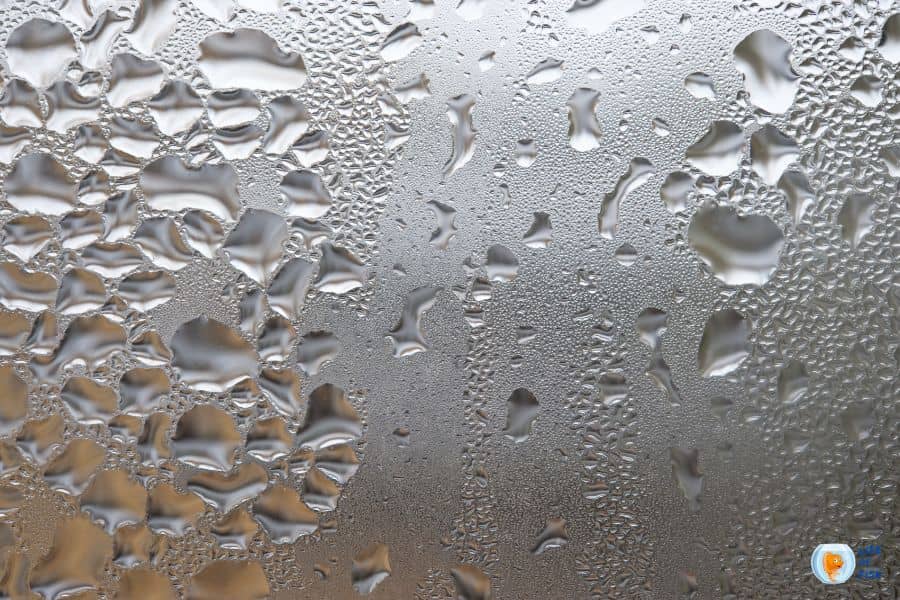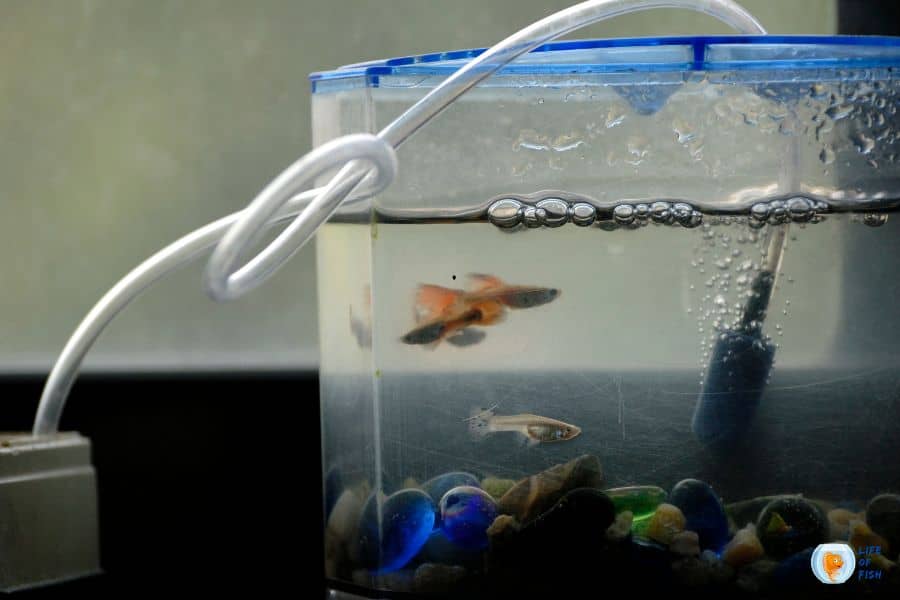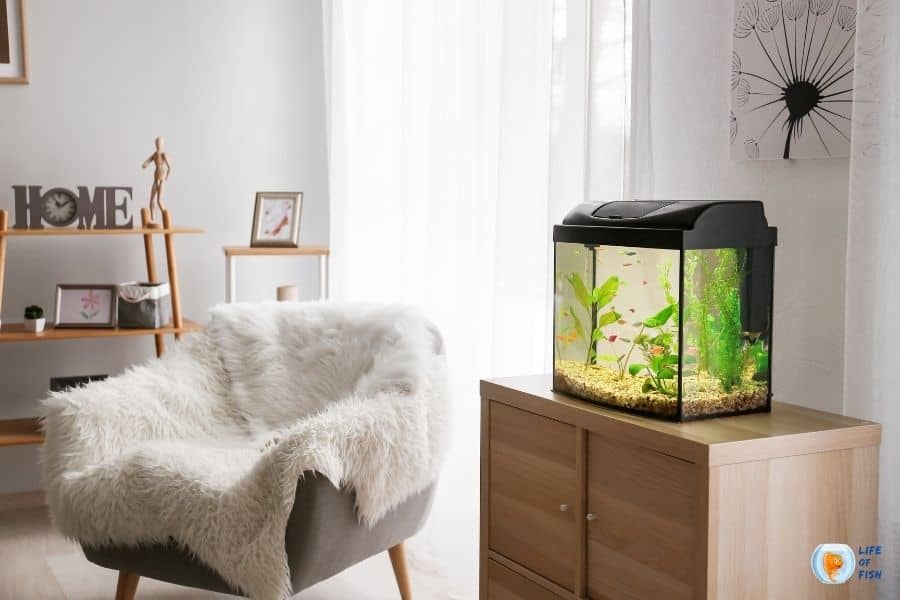Most aquarium fish are good jumpers, therefore you need a tight-fitting lid in your fish tank. A lid also helps maintain humidity and water temperature and prevent evaporation. Due to humidity, there could be condensation in the tank hood. But how to stop condensation in the fish tank hood?
Water condensation can be a real problem, not just aesthetically but also for the safety of your fish. When water droplets form on the inside of the hood and fall back into the tank, they can sometimes contact the electric components of the filter and cause a short circuit. In addition, the water droplets can cause corrosion of the metal parts of the tank.

Fortunately, you can do several things to prevent water condensation on your fish tank hood. We’ll explore a few of those options in this article. But, let’s discuss why condensation happens in our fish tanks.
Why Is There Condensation On My Fish Tank Lid?
Jump To
The main reason water droplets form on the inside of your fish tank hood is due to the difference in temperatures between the air inside the hood and the air outside the hood. If the temperature inside the hood is higher than that outside the hood, water droplets will form inside the hood.
A few things can cause the temperature inside the hood to be higher than the temperature outside the hood. One common reason is if the hood is not properly ventilated. If the hood is not ventilated, the warm air inside the hood will rise and try to escape through any cracks or openings. This will cause the air inside the hood to be cooler than the air outside the hood, and water droplets will form.
Another common reason for water condensation inside your fish tank hood is the humidity level inside the hood. If the humidity level inside the hood is higher than the humidity outside the hood, water droplets will form inside the hood.
Another common reason for water condensation on the inside of your fish tank hood is the evaporation of water inside the tank. When water evaporates, it goes up in the form of water vapor. This water vapor will rise and collect on the inside of the hood. As the water vapor condenses, it will form water droplets.
Is Condensation In A Fish Tank Bad?
Condensation in a fish tank is not necessarily a bad thing. If you keep the tank open, the evaporation can cause unbalanced levels of minerals in the fish tank water. The changes in water chemistry may not be ideal for your fish or plants.
When you keep the fish tank closed with a lid, condensation will bring back the evaporated water and maintain a more stable water chemistry. Some people believe that the slight rise in humidity caused by the condensation can actually be beneficial for your fish since it is closer to their natural habitat.
However, there are some drawbacks to condensation in a fish tank. The water droplets can fall back into the tank and contaminate the water (if the lid is contaminated with bacteria and mold, which can happen because of the moisture that remains from condensation). In addition, the water droplets can cause corrosion of the metal parts of the tank and equipment.
Another concern is that the water droplets can short circuit your filter’s or other equipment’s electric components. If this happens, it could be dangerous for your fish and cause an electrical fire.

How To Stop Condensation In Fish Tank Hood?
There is only one way to stop condensation in the fish tank hood; let the air inside the hood escape. In other words, let the tank lid vent. You can accomplish this in a few different ways. The most common way to stop condensation in the fish tank hood is by ventilating the hood. Ventilation will allow the warm air inside the hood to escape and the cooler air outside the hood to enter. This will equalize the temperatures between the two and prevent water condensation.
You can ventilate your fish tank hood by drilling holes in the hood or by installing a fan. If you drill holes, make sure they are big enough for air to flow through easily but not so big that your fish will be able to escape. If you install a fan, make sure it is pointing outwards so that it will push the air out of the hood. You can also install a fan on the lid of your fish tank to help circulate the air and prevent condensation.
Another way to stop condensation in the fish tank hood is by lowering the humidity level inside the hood. You can accomplish this by adding a dehumidifier or by opening the lid of the fish tank to allow the humid air to escape.
But, there are drawbacks to venting the lid. Evaporation can change the water chemistry; thus, it is important to keep an eye on the levels of minerals in the fish tank water. In addition, when you lower the humidity level inside the hood, you also lower the temperature. This can be a problem if your fish are tropical fish since they need warm water to survive.
Another side effect is the build-up of non-volatile minerals on the glass. This build-up can be difficult to remove and can eventually lead to the formation of a white haze on the glass. The solution? A condensation Tray.
What Is A Condensation Tray?
A condensation tray is a tray that goes under the lid of the fish tank and collects the water droplets that form from the condensation. The water droplets will form under the condensation tray and then drip down into the tank. Condensation trays are usually made out of acrylic or glass. They are easy to clean and can be reused. And they do not change the water chemistry or temperature inside the fish tank.
Plus, they can be used with filters and other equipment that might be sensitive to the changes in water chemistry caused by evaporation. Condensation trays are a great way to stop condensation in the fish tank hood without having to vent the lid. They are also a great way to keep the water inside the fish tank clean and free of contaminants.
How to Use A Condensation Tray?
There are no technical skills required to use a condensation tray. All you need to do is place the tray under the lid of the fish tank. Ensure the tray is big enough to catch all the water droplets from the condensation. You can also buy a condensation tray that has a lip on it. This lip will help to prevent the water droplets from falling into the fish tank.
Cleaning A Condensation Tray
Cleaning a condensation tray is easy. All you need to do is remove the tray from the fish tank and empty it into the sink. Rinse the tray with clean water and then put it back under the lid of the fish tank. You can also clean the tray with a vinegar solution. Just mix 1 part vinegar with three parts water and soak the tray in the solution for 10 minutes. Rinse the tray with clean water and then put it back under the lid of the fish tank.

Diy Aquarium Condensation Tray
If buying an aquarium condensation tray is not an option, you can easily make one yourself. All you need is a piece of acrylic or glass that is big enough to fit under the lid of the fish tank. Cut the piece of acrylic or glass to size and then drill a hole in the center of it. This hole will be used to drain the water droplets from the condensation tray.
Next, glue the piece of acrylic or glass to the underside of the fish tank lid. Make sure the hole faces downwards so the water droplets can drain into the fish tank. You can also use silicone to glue the tray to the lid. Just make sure the silicone is aquarium safe. And that’s it! You now have a DIY aquarium condensation tray that will help to stop condensation in the fish tank hood.
You can also make a temporary condensation tray using Aluminium foil. Make sure that you have enough of the foil on hand before starting to glue it together because you will probably need more than one roll.
Begin by laying down several layers of foil until you reach a thickness equal to or greater than the size of your aquarium. Fold in the corners until your sheet resembles a tray, and then glue the corners together with silicone. Place your newly made tray inside the aquarium underneath the lid to catch any condensation that might form, and replace it as needed.
Conclusion
Condensation in the fish tank hood is a common problem that can be solved easily with a condensation tray. Condensation trays are easy to use and can be reused. They are also a great way to keep the water inside the fish tank clean and free of contaminants. If you don’t want to buy a condensation tray, you can easily make one yourself using a piece of acrylic or glass. You can also make a temporary condensation tray using aluminum foil.

Related questions
How fast does water evaporate in a fish tank?
The rate of evaporation in a fish tank depends on many factors, such as the tank size, the water temperature, and the humidity in the room. Generally, a small fish tank evaporates faster than a large one. Generally, a 40-gallon tank evaporates approximately half a gallon every day. However, depending on the aforementioned conditions, this number could be greater or lower.
Why is my fish tank water evaporating so quickly?
The most common reason the water evaporates is the room’s high temperature. The warmer the room, the faster the water will evaporate. Another reason the water evaporates quickly is if the fish tank is located in a dry area. Dry areas have low humidity, which causes the water to evaporate at a faster rate. If you notice that your fish tank water is evaporating quickly, try to find the cause and fix it. Some steps you can take to reduce the evaporation rate are:
- Turn on a humidifier in the room
- Move the fish tank to a cooler area
- Reduce the number of lights on in the room
- Place a lid on the fish tank
Read Next : Do Snails Eat Algae? They Do. But!
